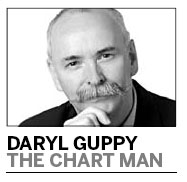Daryl Guppy
The discipline of knowing when to leave the market
By Daryl Guppy (China Daily)
Updated: 2010-11-01 13:20
 |
Large Medium Small |
We trade in markets in the hope of making a profit. For many people this is summarized as buy low and sell at a higher price. How we take the profit shapes the behavior of the market.

Market success comes from discipline and discipline is created on the foundation of a trading plan. At its most basic, the trading plan has an entry price and a planned exit price. Getting into the trade is easy - you just pay. Getting out of the trade is more difficult because this taps into our greed and this alters our behavior. Deciding how much profit is acceptable or desirable is a challenge for all traders.
The behavior of markets is the aggregate behavior of individuals. It is very easy to show how individual make incorrect or inconsistent decisions. Many studies show people have an inadequate understanding of risk and reward and it is not just limited to the amateurs in the market.
Financial education does not overcome these problems. Some of the most highly educated in the financial industry managed to reduce major financial institutions to rubble in 2008 through a less than perfect understanding of risk and reward. Success in the market also depends on understanding the behavior of market participants. This understanding can start on a more personal level and then the lessons are usefully projected on to a broader market level.
The reward section of the risk and reward equation tells us how much reward we expect to receive for the risk we take in the market. This figure can be exactly calculated because the market offers a range of potential exit prices. The reward calculation starts with our preferred entry price. A trade plan always makes an assumption that the entry is within a defined entry price range.
In a fast moving market it is not always possible to enter a trade at the lower edge of the planned entry trading range. Sometimes the trader enters the trade at the upper edge of the entry trading range and this reduces the percentage profit in the trade when the trade plan exit price target is achieved.
Aggressive and confident traders may enter the trade and pay a little more than they originally planned. They enter at a higher price because the trade has shown good momentum strength. The higher price entry reduces the trade profit if the trade is closed near the trade plan target price.
Should traders exit at the trade plan target price or should they exit at the trade plan percentage profit target? The answer depends on the market conditions and individual reaction to greed. In a weak market, or a market where there is not strong upwards momentum, the trade should be closed when the trade plan target price is achieved. The reason is because there is a reduced probability the price will continue to move above the target price level.
In a strong market with good upwards momentum the trade exit is made when the percentage profit target is achieved. This may be higher than the original trade plan exit price. Traders use the percentage profit target because the momentum is strong and there is an increased probability the price will continue to rise. In this situation the trader also uses a protect-profit stop to let the profit grow larger than the original trade plan target.
In a strong market when the trade reaches the trade plan price target the trader tightens the exit condition to protect the profit. When the trade continues to move higher the trader adjusts the protect-profit condition because the momentum of the trend has proved stronger.
A third trade management method uses a defined exit condition. This rests on methods used to define the end of the upward trend. It can be as simple as a moving average crossover or a move below an upward trend line. Or it can rest on a much more complex matrix of factors. This exit method is most suitable for a strong trending market where price targets and percentage profit targets are regularly exceeded.
Every trade has a trade plan which includes a planned entry price and a planned exit price or a planned exit condition. The trader must decide which target he will use - the trade plan exit price or the trade percentage profit exit target or the exit condition. This decision makes the difference between a profitable trader and a very successful trader.
Success in the market depends on the behavior of individual traders as price moves towards their planned profit targets or exit conditions. When many individual traders decide to take profits the market loses momentum and develops a sideways pattern. Watching the aggregated behavior of others in the market provides essential information about the best exit method to use in the current market conditions.
Daryl Guppy is a well-known international financial technical analysis expert.